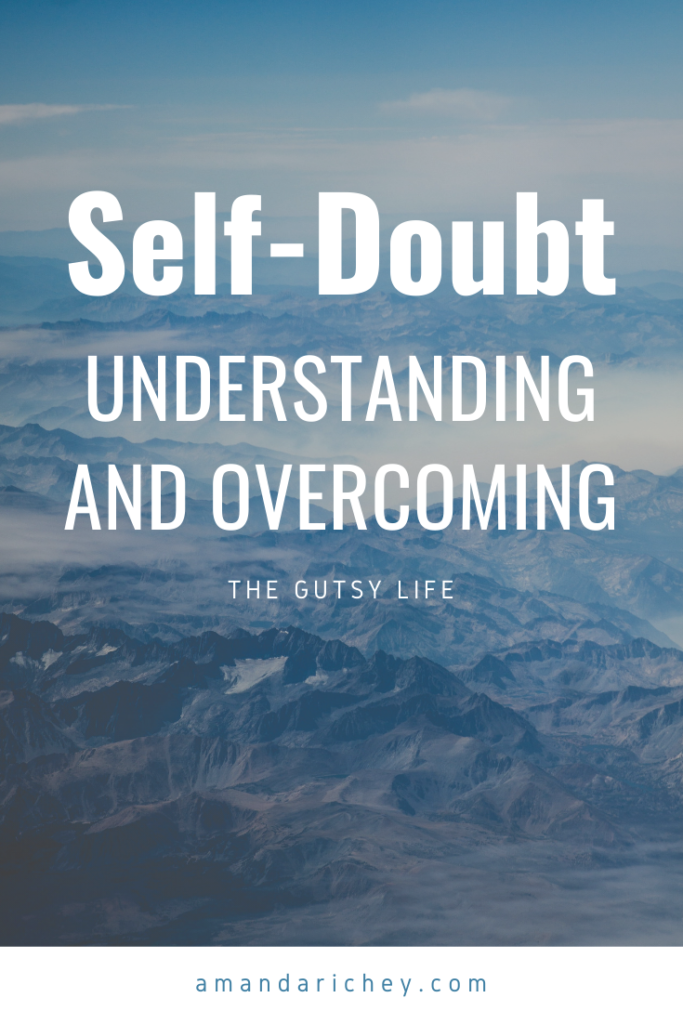Self-doubt is a common topic among my group of friends, am I right? Especially with women, self-doubt tends to be the main reason women hold themselves back form really going for it in life.

The truth is: self-doubt is a limiting belief; it is based on many limiting beliefs you have been telling yourself or have been told since you were young.
Many people group fear and doubt, especially self-doubt, into the same category (mainly just referred to as fear) but I would argue that self-doubt has a different root-cause than fear, and understanding the differences is integral to understanding how to overcome self-doubt and fear so that you can go about living the gutsiest version of your life.
In this post I hope to explain to you the scientific basis for self-doubt and what the brain is doing when you are doubting yourself so that you can stop asking yourself: “What the F*%#k is my problem?” and start doing the Gutsy things you are meant to be doing. I also want to help you to identify when you are in doubt and how to overcome and push through it as well as look at how self-doubt, fear, and limiting beliefs are intertwined.
Doubt-the definition
Merriam-Webster Dictionary defines doubt as:
1: to call into question the truth of: to be uncertain or in doubt about
2a: to lack confidence in : DISTRUST
Of course, when we really talk about doubt we are not talking about others we are most often talking of doubting ourselves and therefore here is the definition of self-doubt:
1: a lack of faith in oneself: a feeling of doubt or uncertainty about one’s abilities, actions, etc.
What science says about self-doubt
In the psychological and scientific community self-doubt is often associated with the term impostor syndrome (or impostor phenomenon). The term was coined by Dr. Pauline Clance and Dr. Suzanne Imes in 1978. In their paper (see references) they defined it as: “an individual experience of self-perceived intellectual phoniness”. They discovered this phenomenon in researching 150 high-achieving women who despite receiving many accolades and professional success, reported feelings of fraud and attributed their success to luck or others overestimating their abilities.
Since this initial study, many more researchers have found evidence for impostor syndrome, most common in women but also affecting men. Studies suggest that more than 70% of people experience impostor syndrome at some point in their career. Individuals who live with impostor syndrome commonly relate self-esteem and self-worth to others, they often exhibit some forms of anxiety or depression, and often have perfectionist tendencies.
I have suffered from impostor syndrome in my professional and personal life. When I entered grad school I felt confident in my abilities and my knowledge but as time went on I began to feel out of place and my fears of inadequacy began to creep into my head. I have also experienced this in my blog writing; I often doubt whether I have the authority or the right to be writing about personal development and self-growth when I am still on the journey myself.
I think we all can relate to this in some form or another, even if we don’t want to label it as ‘impostor’, we all find ways to doubt our abilities and our worthiness. What helps me is understanding the way my brain works and why it brings up thoughts of self-doubt and self-judgment.
How the brain handles self-doubt
Often, self-doubt is most strongly felt in new situations or circumstances. These feelings of self-doubt are based in fear, and feelings of fear are really about wanting to protect ourselves from feeling negative emotions. As I explained in my post on fear, your brain wants to keep you alive and fear is a critical component of survival. Fear is a primitive mostly automatic alarm system in our body to warn against threats to survival.
Millenia ago, when our brains were first evolving fear existed as a fear of bodily harm and death, these days fear exists as any perceived threat. For some people their brain perceives the biggest threat as feeling a negative thought such as shame, rejection, regret. For others our brain may perceive the greatest threat as a threat to our ego and self-worth, for others it may be the fear of not belonging, or the fear of scarcity. This is where self-doubt and fear are connected. If you are in self-doubt, chances are, your body perceives this doubt as fear.
Fear and self-doubt in the brain
We have a conscious mind and a subconscious mind. Our conscious mind is controlled by the prefrontal cortex, a section of your brain located right behind your forehead. This region is responsible for decision making, self-control, willpower, and regulating behavior and does not fully develop until after puberty. Our subconscious mind however, is fully developed at birth, and is controlled by the basal ganglia which is responsible for emotions, habits, behavior, basic instincts, etc.
The subconscious mind is in charge, even when we think our conscious mind is running things.
The fear response starts in the subconscious mind, in a region of the brain called the amygdala, closely related to the basal ganglia. When in fear, a threat stimulus triggers a fear response in the amygdala, which activates areas responsible for motor functions such as ‘fight or flight’ responses as well as releasing stress hormones. This results in the body responding to danger by becoming hyperalert. The analytical or concious response to fear occurs in the prefrontal cortex which helps the brain interpret the perceived threat. That perception of whether a threat is real depends on whether we feel we are in control.
What this means to you: fear and self-doubt are automatic or habitual responses that your brain creates based on the thoughts that you feed it. These subconscious or habitual responses to the world around us are based on ‘truths’ we have internalized. Even if we know better and can use our prefrontal cortex to analyze and rationalize these beliefs: that we are not in danger, that we are worthy, our subconscious mind is still controlling and running the show determining how and what we feel and believe about ourselves and the world around us. Hello self-doubt!
This is hugely important because, while you may have some awesome subconscious beliefs, chances are you have quite a few ‘limiting beliefs’ that are not based in reality and are thus limiting yourself and your potential and causing you to be in self-doubt.

How to identify if you are in self-doubt
First Ask yourself: do you engage in any of the following regularly?
- Harboring limiting beliefs
- Procrastination: excessive gathering of information
- Perfection: will not finish or commit because it is not perfect
- Distraction: focusing on the urgent or unimportant tasks
- Diversion: doing something else entirely making yourself feel productive and busy
- Numbing: seeking outside feelings of satisfaction
Look at areas in your life and your past that may have resulted in self-doubt:
- Limiting beliefs learned in childhood
- Past relationships
- Work environment/past work experiences
- Your environment and who you surround yourself with
- Traumatic events
Then try looking at an area of your life where you feel you are coming up short or have plateaued. An area where no matter how hard you try you just can’t seem to get ahead, get out, move on. Try writing down the first five thoughts that come to your mind about that area of your life. What comes up? Fear? Self-doubt? Thoughts of worthiness?
How to overcome and push through self-doubt
Once you have identified the areas in your life where self-doubt exists you need to then focus on re-writing your story. This is a huge step and chances are you have many limiting beliefs about yourself that are causing this self-doubt. First:
- Get supper clear on who you are, what you want, and what your strengths and weaknesses are. Understanding yourself and what you are capable of is key to identifying when you should and should not be doubting yourself! Check out my post all about personality types and your unique strengths and weaknesses, and take the FREE Personality Purpose quiz
- Identify your limiting beliefs and then re-write your story. I have an in-depth post all about limiting beliefs if you want more info as well as a limiting beliefs worksheet that will help you to identify, and then rewrite your limiting beliefs.
- Create Positive Affirmations about yourself and who you are based on what you have learned from 1 and 2
- Get Coached– there are just some things you just can’t do without a kick in the rear. Facing those fears is scary, am I right?! That is what I am here for; to be your kick in the butt. To hold you accountable and make sure you get to the gutsy life on the other side of your fears. So, lets talk about how I can help you live a Gutsy Life.
How self- doubt relates to fear and limiting beliefs
Many people group fear and self-doubt into the same category. I would argue that self-doubt’s root-cause is different from fear, and understanding the differences is integral to understanding how to overcome it.
In discussing the science, you can see that fear is an automatic response your brain creates based on the thoughts that you feed it. Self-doubt, on the other hand comes from limiting beliefs that your subconscious has internalized and then acts on, without you being aware. They are both occurring in the subconscious part of our brain, but the root cause is different. Fear is about how you are telling your brain to feel, self-doubt is about internalized ‘truths’ you hold about yourself and the world that your brain then acts on without you being aware.
To change your fear response you need to tell your brain new thoughts.
To change your self-doubt you need to identify the limiting beliefs buried deep in your subconscious and rewrite them.
I know this sounds a bit overwhelming as well as overly simplistic, BUT the truth is:
You control your thoughts and you can change them
If you feel like fear is what is holding you back, head over to my post all about fear and overcoming fear. If Self-doubt is your game than do these steps: know yourself and take the Personality Purpose Quiz, and then work on the Limiting Beliefs Worksheet and work on re-writing that story into new positive affirmations!
I know it is hard, but this work is so important and I believe in you!

References
Clance, Pauline R.; Imes, Suzanne A. (Fall 1978). “The Impostor Phenomenon in High Achieving Women: Dynamics and Therapeutic Intervention” (PDF). Psychotherapy: Theory, Research & Practice. 15 (3): 241–247.
American Psychiatric Association (2000a). Diagnostic and statistical manual of mental disorders (Fourth Edition, Text Revision: DSM-IV-TR ed.). Washington, DC: American Psychiatric Publishing, Inc.
Matthews, Gail; Clance, Pauline Rose (February 1985). “Treatment of the impostor phenomenon in psychotherapy clients”. Psychotherapy in Private Practice. 3 (1): 71–81. doi:10.1300/J294v03n01_09.



It really helped when you said that we feel self-doubt when we find ourselves in new situations. I’m thinking of starting a business and since I don’t have any previous experiences, there are times when I feel like I can’t accomplish any of my goals. Maybe I should buy a self-coaching gift box that can help me motivate myself as a Christmas present.
Self-doubt will always come up when you are in a new situation and creating a business is exactly that! Don’t take it as a sign that you made a bad choice or you are failing. Self-doubt is perfectly normal and may even be good evidence that you are on the right track! Check out this post: https://www.amandarichey.com/your-brain-willpower-motivation-limiting-beliefs/ there are some great Free resources to start you off with some self-coaching! This is the perfect time to treat yourself! Go for it!
Honesty is key. As a life coach, you are confronted with difficult and personal life situations daily. If you don’t know what to tell someone during a tough conversation, stick to honesty.
Thank you, honesty will always serve you.
Thank you for sharing the article about overcoming self-doubts. Your insights are truly valuable. If you’re seeking more motivation and guidance, I highly recommend considering Jesse Lebeau as he is known as the best youth motivational speaker. His expertise could be a game-changer in overcoming challenges and boosting self-confidence.
https://www.jesselebeau.com/
Your point of view caught my eye and was very interesting. Thanks. I have a question for you. https://accounts.binance.com/kz/register?ref=PORL8W0Z